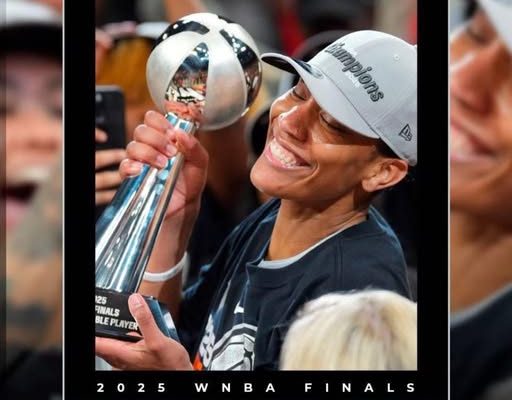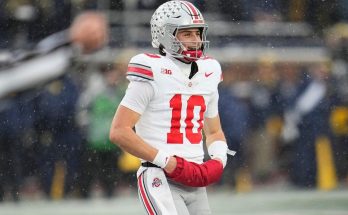1.5 million strong The WNBA Finals are drawing their largest audience in 25 years — history in the making
The numbers don’t lie — the WNBA is in the middle of a revolution. For years, fans and players alike have been calling for recognition, for investment, and for visibility that matches the talent and heart displayed night after night on the court. Now, that moment has finally arrived. The 2025 WNBA Finals have captivated audiences nationwide, drawing an average of 1.5 million viewers per game — the league’s largest television audience in a quarter of a century. It’s not just a milestone for women’s basketball; it’s a defining moment for the growth of the sport, for women’s athletics, and for the cultural conversation surrounding equality in professional sports.
The buzz surrounding this year’s Finals has been unlike anything in recent memory. From pre-game coverage to viral social media moments, the energy has been electric. Fans have packed arenas, celebrities have filled courtside seats, and young girls everywhere have watched with awe as their heroes took the floor with unrelenting determination. This isn’t just about basketball — it’s about representation, empowerment, and the long-overdue acknowledgment that the WNBA belongs squarely in the spotlight.
The 2025 Finals feel different because they are different. For the first time in decades, the momentum of the WNBA has reached a cultural crescendo, breaking through the noise of traditional sports media. The matchups are fierce, the narratives are powerful, and the players are no longer just athletes — they’re icons of persistence, skill, and authenticity. From Caitlin Clark’s record-shattering rookie season to A’ja Wilson’s relentless dominance and leadership, the league has found itself overflowing with talent that captures both headlines and hearts.
What makes this surge in viewership so remarkable is that it didn’t come from a sudden marketing gimmick or a single viral moment. It’s been years in the making — a steady climb built on the foundation of passion, advocacy, and the tireless work of players who refused to settle for less. The WNBA has long been home to some of the most technically skilled, disciplined, and dedicated athletes in the world, but the infrastructure around it hadn’t always matched that excellence. Now, with better media coverage, stronger sponsorships, and growing investment from major brands, the league finally has the platform it deserves. And when given the chance to shine, it has done more than deliver — it has made history.
The 1.5 million average viewers mark isn’t just a number — it’s a statement. It represents the power of visibility and the hunger of fans who have been waiting for a product that mirrors the energy, competitiveness, and storytelling of the best basketball has to offer. It’s also proof that women’s sports aren’t a “niche” market; they’re a vibrant, profitable, and compelling force in the modern sports landscape.
What’s happening now is the result of both evolution and revolution. Social media has given players direct access to fans, allowing them to build personal brands and connect authentically. Platforms like TikTok and Instagram have amplified moments that once would have disappeared into highlight reels with little attention. Instead, they’re now viral sensations — dunks, clutch threes, emotional press conferences, and even behind-the-scenes team moments are reaching millions. The WNBA’s biggest stars aren’t just trending for their stats; they’re shaping conversations about identity, leadership, and empowerment.
You can feel the difference in how people are watching, too. Families are tuning in together. Kids are wearing WNBA jerseys to school. Mainstream sports networks are devoting prime airtime to analysis and postgame breakdowns. The league has become a cultural touchpoint, a space where fans can rally behind excellence and equality in the same breath. The Finals aren’t just a series of games; they’re a culmination of everything that’s been building — years of hard work, advocacy, and belief that women’s basketball could stand on its own as a premier sporting event.
And it’s not just the audience that’s grown — the atmosphere inside the arenas is unlike anything seen before. Sold-out crowds, roaring chants, and passionate energy have transformed these games into experiences that rival any major sporting event. Players have spoken openly about how they can feel the shift — that something special is happening, something bigger than basketball. For many veterans who have spent years fighting for attention and respect, these moments are deeply emotional. They’re seeing in real time what they always knew was possible: that people care deeply about women’s basketball when given the opportunity to witness its brilliance.
Behind the scenes, the league’s leadership has played an instrumental role in this rise. Commissioner Cathy Engelbert’s vision of growing the WNBA through strategic partnerships, improved media rights deals, and global outreach is beginning to bear fruit. The integration of tech companies, fashion brands, and entertainment partners has widened the league’s reach far beyond traditional sports audiences. It’s no longer just about the game — it’s about the culture surrounding it. From tunnel fashion to player-led podcasts, from community initiatives to documentaries, the WNBA has woven itself into the broader tapestry of pop culture.
The Finals themselves have been nothing short of spectacular. Every possession feels like it carries the weight of history. The skill level is breathtaking — from the fluid passing to the suffocating defense and clutch shooting that leaves fans on the edge of their seats. The narratives have been riveting: veterans chasing legacies, rookies making history, and coaches crafting chess matches that showcase the tactical depth of the game. Viewers aren’t just watching for entertainment; they’re watching because they feel invested in the stories being told on and off the court.
The 1.5 million milestone also reflects a shift in how media organizations value women’s sports. Networks have finally recognized that coverage drives interest — not the other way around. When games are accessible, promoted, and treated with the same seriousness as men’s leagues, audiences respond. ESPN, ABC, and streaming platforms have increased exposure and given fans consistent access to watch their favorite teams. The result is what we’re seeing now — record-breaking viewership that continues to climb.
Perhaps the most heartwarming part of this moment is the generational impact it’s creating. Young girls growing up today don’t just have to look to men’s basketball for inspiration; they have heroes in the WNBA who reflect their dreams and identities. They can see what excellence looks like, and more importantly, they can believe that it’s achievable. For parents, teachers, and coaches, this growth in visibility means that the message of opportunity and equality is stronger than ever. Representation matters, and the Finals are serving as a beacon of that truth.
Even beyond sports, this success story carries weight. It’s about what happens when a system begins to value women’s work, talent, and contributions equally. It’s a reflection of how social progress intersects with entertainment, business, and media. Companies that once hesitated to invest in women’s sports are now competing for partnerships, understanding that the emotional connection fans have with these athletes translates into real influence and loyalty.
And it’s not slowing down. The data suggests that the Finals could break additional streaming and social engagement records before the series concludes. Ticket demand has soared, merchandise sales have spiked, and online conversations about the WNBA have grown exponentially. Each game feels like another page in a larger story — one where the league’s future looks brighter than ever before.
In the end, the headline says it all: 1.5 million strong. It’s not just a statistic; it’s a symbol of arrival. The WNBA has moved beyond proving its worth. It has solidified its place in the mainstream sports landscape — not as a companion to men’s basketball, but as a powerhouse in its own right. The players, fans, and supporters who never gave up on this league are witnessing history unfold, moment by moment.
Years from now, people will look back at these Finals as the turning point — the time when the world finally paid attention, when the talent, heart, and dedication of these athletes could no longer be ignored. The movement that started as a fight for equality has become a celebration of excellence. This is more than just a Finals series; it’s a cultural awakening, a declaration that women’s basketball has always been great — the world is simply catching up.
The energy is contagious, the future is limitless, and the message is clear: the WNBA isn’t just growing — it’s thriving. The players have earned their spotlight, the fans have found their voice, and the league has claimed its place at the center of the sports world.
1.5 million strong and counting — a number that represents not just viewership, but belief. Belief in a game that inspires, in players who redefine greatness, and in a league that has become a symbol of progress, power, and pride. The WNBA Finals of 2025 aren’t just making history — they’re shaping the future.



